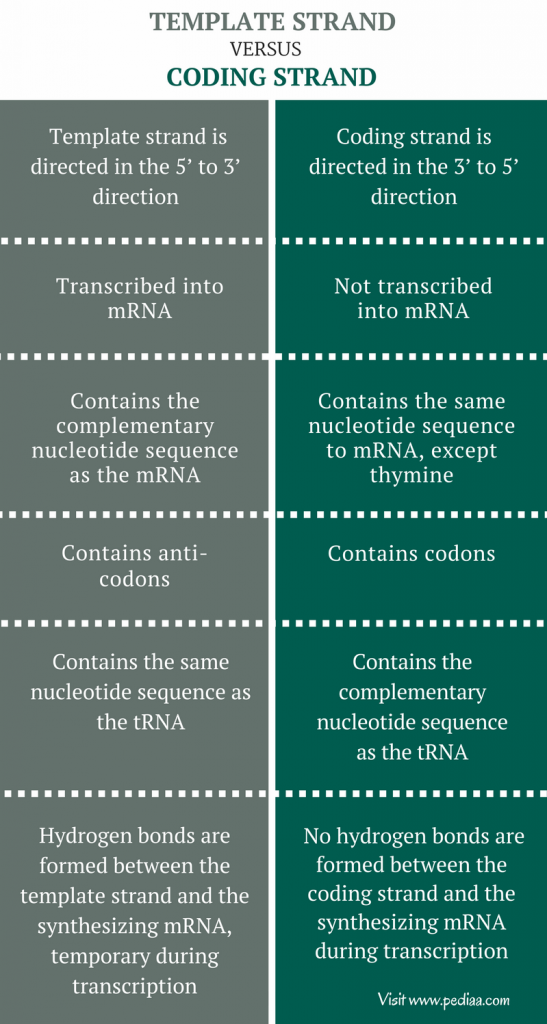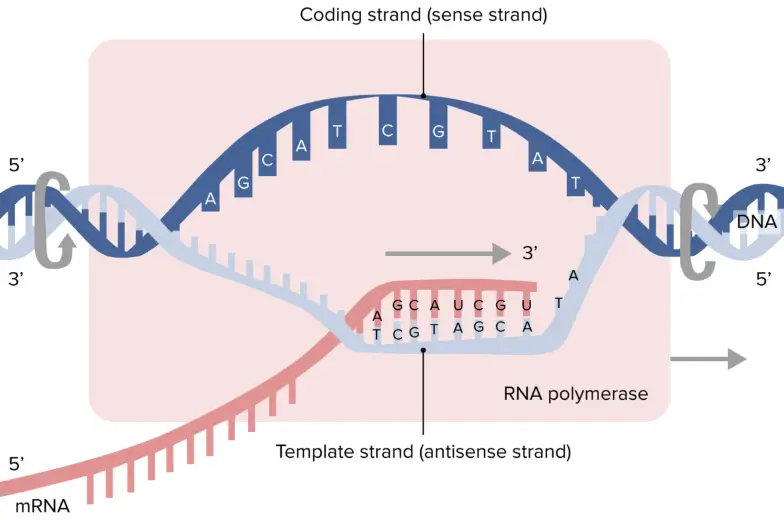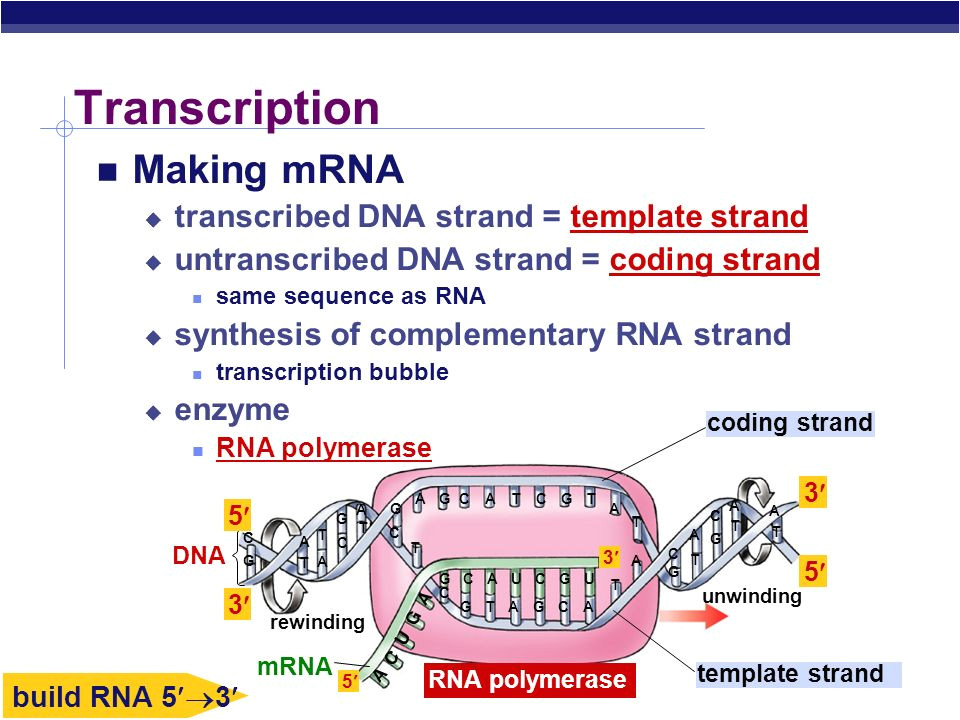Template Strand And Coding Strand
Template Strand And Coding Strand - Web template strand and coding strand refer to the two complementary strands of dna that encode genetic information. Overview of dna structure before delving into the specifics of template and coding strands, let’s briefly outline the structure of dna. The coding strand is the bottom strand. Web the coding strand and template strand in translation. Its sequence is used as a template during transcription to produce an rna molecule. Web the coding strand carries the same sequence as the resulting rna, while the template strand provides the template for transcription and replication. Orfs are sequence segments that begin with a start codon (atg, though see my note below) and end with a stop codon (taa, tag, tga) when read from 5' to 3' in 3. Web the template strand of dna is the strand that is used during transcription to produce rna. The coding strand or the sense strand corresponds to the same sequence as that of the mrna strand. Understanding the differences between these two strands is crucial in comprehending the complex processes of dna replication, transcription, and translation. The rna synthesized is complementary to the template strand. Web position of the template and coding strands during transcription. The dna strand known as the template strand serves as a blueprint for the production of rna, whereas the coding strand is. Web the coding strand and template strand are two complementary strands of dna that play different roles in the. For example, if the coding strand reads atg, the mrna reads. The template strand is the top strand; Often termed as the antisense strand or minus strand. Considering the same dna sequence:. There are a few assumptions you can make. Considering the same dna sequence:. When referring to dna transcription, the coding strand (or informational strand) is the dna strand whose base sequence is identical to the base sequence of the rna transcript produced (although with thymine replaced by uracil). Web in transcription, an rna polymerase uses only one strand of dna, called the template strand, of a gene to. The coding strand serves as a template for mrna synthesis during transcription, while the template strand remains unaltered. When referring to dna transcription, the coding strand (or informational strand) is the dna strand whose base sequence is identical to the base sequence of the rna transcript produced (although with thymine replaced by uracil). Web in transcription, an rna polymerase uses. Overview of dna structure before delving into the specifics of template and coding strands, let’s briefly outline the structure of dna. Web the coding strand is directly involved in protein synthesis, while the template strand serves as a template for rna synthesis. The template strand is usually directed 3’ to 5’ in direction. Most codons specify an amino acid three. Web the nontemplate strand is referred to as the coding strand because its sequence will be the same as that of the new rna molecule. You have the sequence of template strand , that means you have non coding strand. Accurate transcription, dna replication, and proper gene expression rely on the interplay between these two strands. Overview of dna structure. Web coding strand vs template strand science encompasses the fundamental components of dna, with the coding strand and template strand playing pivotal roles. Web what are template strand and coding strand? Accurate transcription, dna replication, and proper gene expression rely on the interplay between these two strands. Oriented in a 3’ to 5’ direction. Here are some features of codons: Orfs are sequence segments that begin with a start codon (atg, though see my note below) and end with a stop codon (taa, tag, tga) when read from 5' to 3' in 3. Web the section shown is part of a protein coding gene. Web what are template strand and coding strand? Web the template strand and the coding strand. Web in transcription, an rna polymerase uses only one strand of dna, called the template strand, of a gene to catalyze synthesis of a complementary, antiparallel rna strand. When referring to dna transcription, the coding strand (or informational strand) is the dna strand whose base sequence is identical to the base sequence of the rna transcript produced (although with thymine. Template strand is directed in the 5’ to 3’ direction. In most organisms, the strand of dna that serves as the. Considering the same dna sequence:. Often termed as the antisense strand or minus strand. Exhibits a 5’ to 3’ orientation. Web what are template strand and coding strand? Web the coding strand is directly involved in protein synthesis, while the template strand serves as a template for rna synthesis. Web the coding strand carries the same sequence as the resulting rna, while the template strand provides the template for transcription and replication. Non coding / template/ antisense are all same. Web the template strand and the coding strand are the two known strands. Exhibits a 5’ to 3’ orientation. Understanding the differences between these two strands is crucial in comprehending the complex processes of dna replication, transcription, and translation. If you want to know the sequence of rna, just remember that rna. The rna sequence mirrors the coding strand of dna, with the exception of uracil replacing thymine. Rna polymerases use ribose nucleotide triphosphate (ntp) precursors, in contrast to dna polymerases, which use deoxyribose nucleotide (dntp) precursors (compared on page. Web the coding strand moves in the 5′ to 3′ direction, opposite to the template strand and it. The coding strand or the sense strand corresponds to the same sequence as that of the mrna strand. Overview of dna structure before delving into the specifics of template and coding strands, let’s briefly outline the structure of dna. Web template strand and coding strand refer to the two complementary strands of dna that encode genetic information. Web the coding strand and template strand in translation. Web in transcription, an rna polymerase uses only one strand of dna, called the template strand, of a gene to catalyze synthesis of a complementary, antiparallel rna strand. When referring to dna transcription, the coding strand (or informational strand) is the dna strand whose base sequence is identical to the base sequence of the rna transcript produced (although with thymine replaced by uracil). The dna strand known as the template strand serves as a blueprint for the production of rna, whereas the coding strand is. Orfs are sequence segments that begin with a start codon (atg, though see my note below) and end with a stop codon (taa, tag, tga) when read from 5' to 3' in 3. Often termed as the antisense strand or minus strand.Difference Between Template and Coding Strand
PPT Transcription PowerPoint Presentation, free download ID3154392
Template Strand Vs Coding Strand Understanding The Difference GRAPHICOLD
Template and coding strand targeting of spacers. A Schematic
Dna Templating
Difference between Sense Strand and Antisense Strand of DNA Dna
Transcription
DNA Transcription Steps and Mechanism • Microbe Online
Coding Versus Template Strand
Difference Between Template and Coding Strand williamsonga.us
Related Post:









